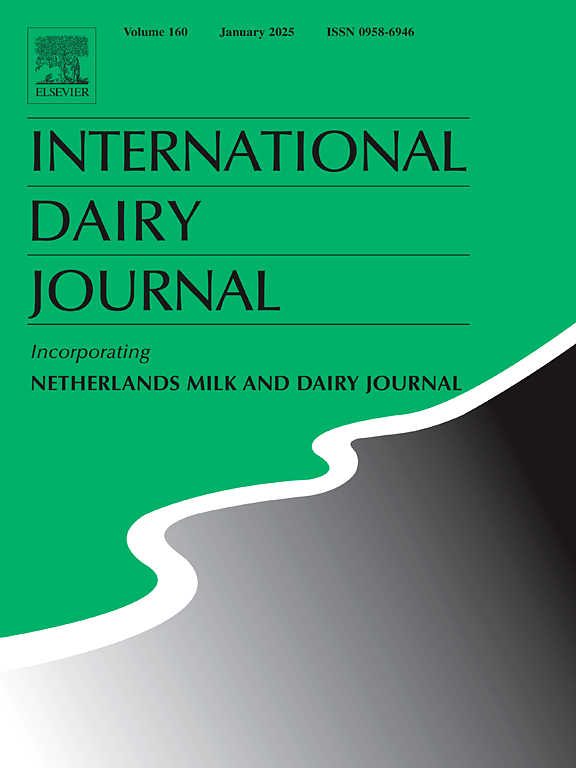Reducing sodium in Kashar cheese by partial substitution of NaCl with KCl: Proteolysis, texture, meltability and sensory characteristics
IF 3.1
3区 农林科学
Q2 FOOD SCIENCE & TECHNOLOGY
引用次数: 0
Abstract
In this study, the effects of partially substituting NaCl with KCl in Kashar cheese to formulate a reduced-sodium cheese was investigated. Four different salt substitute cheese were produced [N8 (control), 8% NaCl; N4, 4% NaCl; N4K4, 4% NaCl + 4% KCl; N2K6, 2% NaCl + 6% KCl] and their chemical composition, proteolysis, hardness, meltability and sensory profiles were monitored over a 60 d of ripening. The results showed that the replacement of NaCl had no significant effect on the pH, moisture or fat contents of the cheese. However, salt, protein and ash contents were significantly affected (P < 0.01). Proteolysis level was significantly higher in NaCl-substituted (N2K6) and reduced-sodium (N4) cheeses. Urea-PAGE electrophoresis revealed different degrees of hydrolysis in the casein fractions. The total FAA concentration increased significantly in the cheese samples during 60 days of ripening, with the highest levels observed in the cheese with the highest KCl content (N2K6). The study also found that cheese with reduced sodium content had lower hardness and higher meltability compared to control cheese (P < 0.01). Sensory analysis revealed that while panelists preferred the flavour of the control cheese, they most appreciated the texture of the reduced-sodium variety, indicating potential consumer acceptance of reduced-sodium cheese through the partial substitution of NaCl by KCl. Sensory analysis revealed that while participants preferred the taste of the full sodium (control) cheese, they liked the texture of the low sodium variety better, suggesting that the partial replacement of NaCl with KCl influences the potential consumer acceptability of the low sodium cheese.
KCl部分取代NaCl降低喀什干酪中的钠:蛋白水解、质构、熔融性和感官特性
本文研究了在喀什干酪中用氯化钾部分取代氯化钠制备低钠干酪的效果。制作了4种不同的盐替代奶酪[N8(对照),8% NaCl;N4, 4% NaCl;N4K4, 4% NaCl + 4% KCl;研究了N2K6 (2% NaCl + 6% KCl)及其化学成分、蛋白水解、硬度、熔融性和感官特性。结果表明,更换NaCl对奶酪的pH、水分和脂肪含量均无显著影响。但盐、蛋白质和灰分含量受到显著影响(P <;0.01)。nacl取代(N2K6)和还原钠(N4)奶酪的蛋白水解水平显著高于其他奶酪。尿素- page电泳显示酪蛋白部分存在不同程度的水解。奶酪样品中总FAA浓度在成熟的60天内显著增加,其中KCl (N2K6)含量最高的奶酪中FAA浓度最高。研究还发现,与对照奶酪相比,钠含量降低的奶酪硬度更低,可熔化性更高(P <;0.01)。感官分析显示,虽然小组成员更喜欢对照奶酪的味道,但他们最喜欢低钠奶酪的质地,这表明消费者可能会接受低钠奶酪,因为氯化钾部分取代了氯化钠。感官分析显示,虽然参与者更喜欢全钠(对照)奶酪的味道,但他们更喜欢低钠品种的质地,这表明用KCl部分替代NaCl影响了消费者对低钠奶酪的潜在接受度。
本文章由计算机程序翻译,如有差异,请以英文原文为准。
求助全文
约1分钟内获得全文
求助全文
来源期刊

International Dairy Journal
工程技术-食品科技
CiteScore
6.50
自引率
9.70%
发文量
200
审稿时长
49 days
期刊介绍:
The International Dairy Journal publishes significant advancements in dairy science and technology in the form of research articles and critical reviews that are of relevance to the broader international dairy community. Within this scope, research on the science and technology of milk and dairy products and the nutritional and health aspects of dairy foods are included; the journal pays particular attention to applied research and its interface with the dairy industry.
The journal''s coverage includes the following, where directly applicable to dairy science and technology:
• Chemistry and physico-chemical properties of milk constituents
• Microbiology, food safety, enzymology, biotechnology
• Processing and engineering
• Emulsion science, food structure, and texture
• Raw material quality and effect on relevant products
• Flavour and off-flavour development
• Technological functionality and applications of dairy ingredients
• Sensory and consumer sciences
• Nutrition and substantiation of human health implications of milk components or dairy products
International Dairy Journal does not publish papers related to milk production, animal health and other aspects of on-farm milk production unless there is a clear relationship to dairy technology, human health or final product quality.
 求助内容:
求助内容: 应助结果提醒方式:
应助结果提醒方式:


